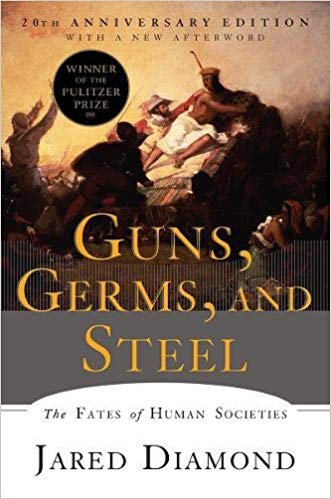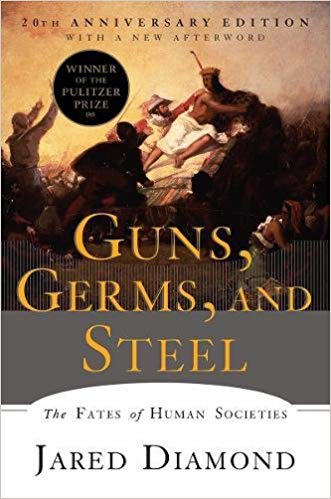Guns Germs and Steel


Guns Germs and Steel is a very interesting and entertaining book. Similar to the last book I reviewed, Malcolm Gladwell’s Outliers, Gun’s Germs and Steel challenges the reader’s view of the world. It starts with a very simple narrative that we are all familiar with and then starts asking some questions that have really been absent in the discussion previously.
The book starts talking about a familiar story, European Colonial Expansion. Columbus sails across the Atlantic to the “New World”. He discovers a bunch of natives already living there. Somehow over the next century or two, the Europeans come to dominate the natives. Similar stories happen in Africa and in Australia/New Zealand. How are the Europeans able to do this?
The general answer is reflected in the title of the book: They had “Guns, Germs, and Steel”. That is to say: The Europeans had superior weaponry. They brought a bunch of diseases with them. They also had superior technology. That is all true, but it begs a deeper question: How is it that the Europeans possessed these superior weapons, diseases, and technology, and the natives did not?
This book exists to answer that question. Jared Diamond delves deep into this question and provides some compelling scientific evidence for his conclusions. He draws several conclusions and they are all interrelated.
One of his most important conclusions is the importance of farming. In a hunter-gatherer society, everyone is constantly preoccupied with feeding themselves, whereas once agriculture is established a small group of farmers can feed a large number of people. This frees people up to be soldiers, merchants, scientists, politicians, etc, which leads to advances in technology and societal organization.
Another conclusion that stuck with me was the diffusion of ideas. Diamond concludes that one reason Asia and Europe were so prosperous is that the continents major axis’ are East to West. It was much easier for ideas and technologies to spread East to West since climate and growing season are fairly constant at the same lattitude. Compare that with the Americas where for an idea to spread from North to South America it would have to cross the deserts of Mexico and the jungles of Panama.
There’s a whole lot more to the book and it is definitely worth reading. It certainly has very little to do with LabVIEW, but I think the discussion of technology is certainly very interesting.